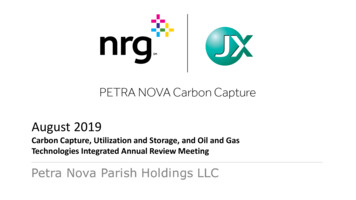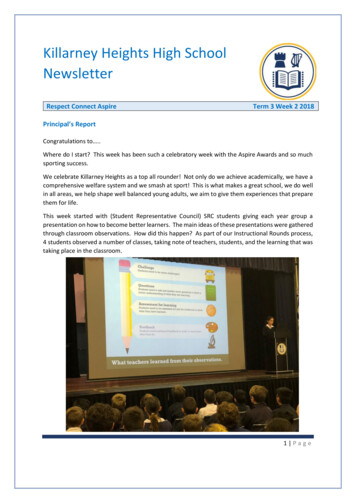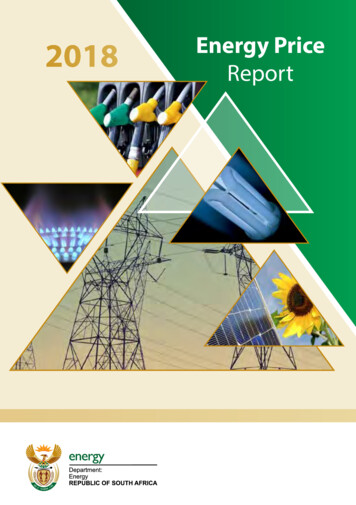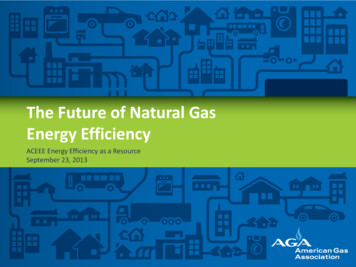
Transcription
August 2019Carbon Capture, Utilization and Storage, and Oil and GasTechnologies Integrated Annual Review Meeting
Commercial StructureThe Partners50%Petra Nova ParishHoldings LLCPetra NovaPower I LLC(COGEN facility)JXTG Holdings is a leading integrated energy,resources, and materials company50%DOEJBICPetra NovaCCS I LLC(Carbon Capturefacility)NRG Energy, Inc. is a large independent powercompany in the USHilcorp Energy is one of the largest privately-heldoil and natural gas E&P companies in the USParish fence linePetra Nova LLC50%50%Texas CoastalVentures, LLCTCV Pipeline, LLCJBIC and NEXI are wholly-owned bythe Japanese government.West RanchOil FieldUS DOE awarded 190 MM grant funded throughthe Clean Coal Power Initiative
Key Project DatesDecember 2016July 2014CarbonCapture FacilityConstructionStartedMay 2010DOE GrantAwarded20102009DOEApplicationPlant OperationsCommences20122011October 2011TCVPartnershipFormed2013May 2013Petra NovaPartnershipFormed2014July 2014FinancingCompleted2017 – 20193-Year DOE Demonstration Period2015December 20162016CO2 PipelineCommissioned20182017January 2017First EOR OilProductionWell is turnedonOctober 20171,000,000tons of CO2capturedSignificant planning required from start to finish!2019
Project Systems1.Petra Nova is partowner of the oilfieldDivert the flue gas from NRG’s WAParish Unit 82.Provide power and steam via dedicated3.Process flue gas in a carbon capture4.Transport CO2 to West Ranch Oil Field5.CO2 Enhanced Oil Recovery operationto produce otherwise unrecoverable oil6.Transport and sell crude oil –COGEN facility, sell surplus power to gridsystem to strip out the CO2through 81 mile long CO2 pipelinemarketing, selling, and transporting therecovered oil
Petra Nova Overview Petra Nova uses a 240 MWequivalent slipstream of flue gasfrom NRG’s 640 MW coal-firedpower plant - W. A. Parish unit 8 CO2 accounts for 13% of the fluegas Petra Nova captures 90% of theCO2 from the processed flue gas When operating at 100%, PetraNova captures 5,200 tons of CO2per day To date, approx. 3.3 million tonsof CO2 have been captured
Carbon Capture System Site LayoutAbsorberCO2 PipelineCompressorQuencherFlue Gas DuctRegeneratorCogeneration(steam & power)
CO2 Pipeline 81 Miles 160 landowners; nocondemnation authority 12” diameter .330 wall pipe (.406 on HDDs) 8 Mainline Valves (MLVs) 1,900 psi at inlet; 1,650 psi atdelivery No intermediate compressionFlat, rural, and colocated with existingutilities7
West Ranch Oil FieldDiscovered in 1938, West Ranch is a “legacy oil field” in Gulf coast region.
Enhanced Oil Recovery ProjectWest Ranch FieldDevelopmentInjectorsProducers Field is being flooded using a “5-spot”pattern (each injector surrounded by 4producers) A comprehensive monitoring, verification,and accounting (MVA) plan is in place totrack the flow of CO2 and to insure that itis sequestered in the reservoir University of Texas Bureau of EconomicGeology (BEG) developed the plan to syncwith oilfield operations and manages theplan during the DOE 3-year demonstrationperiod
Key Components of the Petra Nova MVA Program1. Modeling – development of a fluid flow simulation model using actual loggingand production data2. Mass Balance Accounting – accounting for injected CO23. Pressure Monitoring – monitoring pressure in 10 dedicated AZMI (abovezone monitoring intervals) wells (5 each in two zones)4. Fluid Sampling – collection of pre-injection fluids (brine, gas, oil) in theinjection and AZMI zones5. Groundwater Monitoring – one year of baseline and periodic ongoingsampling of groundwater at several ground water wells6. Soil Gas Monitoring – characterization of soil gases at several sites7. Additional Monitoring – in addition to the BEG program, the oilfield operatoris also monitoring surface level and down hole pressures
West Ranch Central Facility #1CO2/Water/Oil Separation EquipmentRecycle CompressorOil and Water TanksFlash Gas CompressorPiping to and from Manifold SitesWest RanchField CentralFacilities 2 centralprocessing facilitiesto separate oilCO2-water Currently 5manifold sites tomove processfluids All produced CO2and water is reinjected into theformation11
Lessons LearnedRequirements for a successful CCUS project:Technology evaluation and evolutionEngineering and design managementLocation and pipeline developmentCommercial structuring and CO 2 salesInterface/relationship with the oil fieldFinancing structure, including tax incentives, if availableGovernment grant application and administration, if availableEnvironmental study managementPermitting and licensingEPC Selection, Contract Structure and Construction managementIntegrated Project Team – communications and messagingAligned PartnersOperational experience – engage early12
Current Focus for NRGOptimization of the technology that we have in place with the PetraNova project“First-of-a-kind” project creates challenges not seen withconventional projects.Optimization of project economicsProject economics impacted by commodity prices of oil, gas, coal,and powerContinue to develop operational expertiseLimited industry-wide operations expertiseEvaluating and optimizing on tax incentives for the current project,where possibleRegarding 45Q, NRG supports/applauds Congress action tocontinue advancing the development of CCS/CCUS projects acrossthe nation13
Thank You!14
When operating at 100%, Petra Nova captures 5,200 tons of CO. 2. per day Petra Nova uses a 240 MW equivalent slipstream of flue gas from NRG's 640 MW coal -fired power plant - W. A. Parish unit 8 To date, approx. 3.3 million tons of CO. 2. have been captured Petra Nova captures 90% of the CO. 2 . from the processed flue gas











